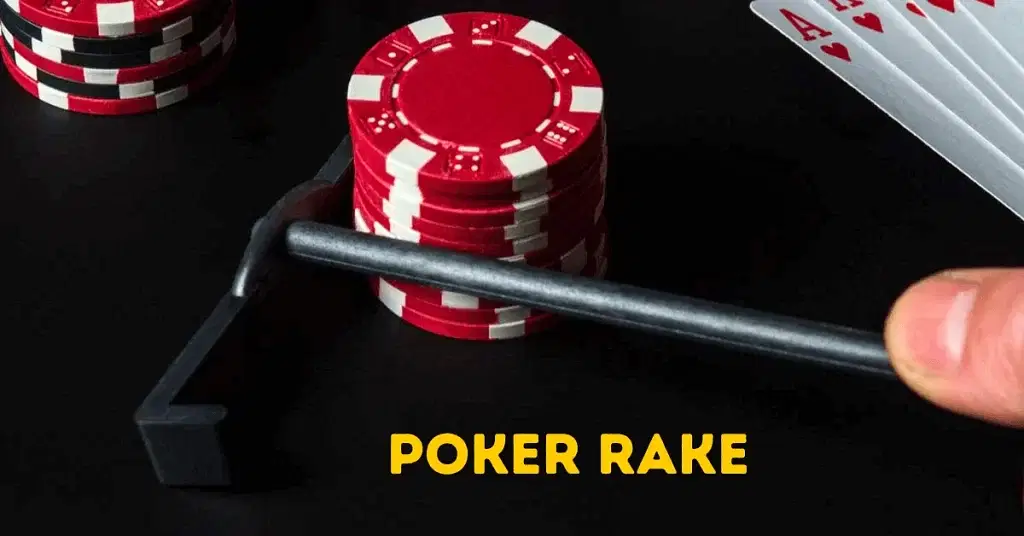In Poker, mastering strategies extend beyond the hands dealt to you. One crucial aspect often overlooked is the poker rake—the commission fee taken by the house for hosting the game. Understanding this aspect of poker is essential for any player aspiring to profitability.
What is Poker Rake?
Poker rake is how casinos or poker rooms make their profit. A small percentage is taken each time a pot is won before the winner receives their share. This fee serves as the house’s earnings. Recognising that rake can vary significantly based on the casino and the playing stakes is essential. Typically, it’s around 2.5% to 10% of the pot, capped at a certain amount.
Types of Poker Rake Structures
Two main rake structures dominate the poker world: fixed-rake and pot-rake. Fixed-rake is straightforward, as a predetermined fee applies to every hand. Pot-rake, however, involves taking a portion of the pot only when it reaches a certain threshold.
Understanding the type of rake applied is vital for strategic players. Fixed-rake games benefit those who prefer consistency, while pot-rake is advantageous for patient players who selectively partake in higher pots. Knowing this distinction empowers players to leverage structure variations to align with personal strategies.
How Rake Affects Your Bottom Line?

Rake, though seemingly small per hand, can significantly affect your poker profits over time. It’s like a silent chisel, shaping your earnings with each round. Cumulatively, rake discounts potential profit margins, making some games less lucrative than they initially appear.
Players need to factor in the rake when calculating potential winnings. Professional players pay close attention, ensuring the table dynamics favour potential profitability. Regular review and adjustment ensure your game remains profitable even after rake deductions.
Table Selection and Its Impact on Rake
When playing poker rakes, selecting the right table becomes pivotal. Not all tables are created equal—some offer better opportunities despite similar rake structures. Opt for tables with weaker opponents where larger pots are ordinary, enabling potential winnings to outweigh the deductions.
Consider the skill levels and playing habits of others at the table. Tables with recreational players might inflate the pot more than experienced participants, thus effortlessly absorbing the rake impact. Strategic table selection, therefore, forms an integral part of successful poker sessions.
Related Read: 10 Expert Tips to Become a Poker Expert: Level Up Your Skills
Online Poker Vs Live Poker Rake
Online poker and live games present distinct raiding methodologies. Players often encounter lower rakes, attractive bonuses, and loyalty programs on online platforms—financial incentives encouraging regular play. Meanwhile, traditional casinos add extra costs to overhead expenses and convenience factors.
Decide based on your preference for environment and opportunity versus sheer convenience. While online nets often save money with lower rake and promotions, live games offer a tangible experience crucial for many players. Weigh each carefully, acknowledging both advantages and challenges naturally progressing between formats.
Rakeback and Loyalty Programs
Rakeback and loyalty programs offer ways to reclaim some of your contributions to the rake. Many poker sites offer players a percentage of the rake taken from them back as a reward. This system rewards consistent play, and your earnings significantly increase over time.
Evaluate platforms offering robust rakeback schemes and cultivate memberships that benefit ongoing participation. Recognising value within loyalty programs can swindle the house advantage, transforming initial rake into longer-term rewards aligned with continuous gameplay investment.
Maximising Value from Poker Tournaments
Understanding how the rake is calculated and implemented is crucial in tournament settings. Unlike cash games, tournaments often incorporate rake into the entry fee. This one-time fee deducts a portion of potential winnings, impacting overall profitability across the tournament scene.
Players should weigh entrance fees against potential payout structures, discerning when contests offer palatable stakes. Typically, tournaments with significant prize pools relative to entry costs provide ideal scenarios, maximising returns on investments marked initially by singular deduction points.
Strategies for Reducing Rake Impact
The impact of optimising poker rake boils down to strategic foresight. Participating in fewer but larger pots reduces how often you contribute to the rake, effectively minimising your overall exposure. Focus on selective play and targeted aggression to keep contributions to a minimum.
Players should observe patterns and gameplay frequency, minimising the long-term impact of personal rake.
Aligning selective participation with a broader strategy reduces net losses and better serves personal financial goals, which is evident across pockets and pocketed outcomes.
Also Read: What are Poker Blinds? Role, Types and Variations
Influence of Stake Levels on Poker Rake
Higher stake levels generally result in higher rake amounts, but there’s a catch—while the percentage remains the same, the capped amount often increases. Thus, the effective rake percentage may be lower than that of lower stake levels, where the cap is reached more quickly.
Balance these considerations with your comfort in playing at higher stakes. Seasons of playing higher pots sometimes unveil broader-scope payout opportunities, accommodating rake costs efficiently. Play within limits, extending optimal strategies across confidently forecast gains against regulated obstacles.
Adapting Strategy for Short-Handed Games
Short-handed games involve fewer players and typically feature higher rake percentages. Adapting your strategy is crucial in these settings, emphasising aggressive play to ensure that pot sizes justify the increased rake.
Embrace the action inherent in short-handed setups, capitalising on size enhancements intersected with positional approaches. Aggressive recalibration goes hand-in-hand with tighter table configurations, seeking impactful outcomes derived from ebbs and flows accommodating heightened tensions.
Calculating Rake to Improve Profitability

A thorough understanding of calculating rake forms the backbone of improving your net profit. Accurately assessing how much rake you’re paying concerning your winnings allows you to target adjustments proactively and directly.
Conduct regular reviews of session performance against rake considerations, equipping yourself with information that sharpens outcomes. Plan sessions with margins accounting for rake realities, pursue consistent advancement and acknowledge sharp data distilled into intelligible decisions poised to bloom within competitive landscapes.
Profit Margins in Tight Vs Loose Tables
Tight and loose tables present distinct challenges and opportunities concerning rake potential. Loose tables create larger pots due to more frequent betting, offsetting the rake’s portion, whereas tight tables often make the rake a more significant portion of the pot due to smaller pot sizes.
Opt for one’s natural profiting inclination, appreciating differing dynamics that work favourably with your style. Loose alliances bring swagger, enveloped by joyous yields, while tight personas seek calculated shores where strategy thrives quietly until tides beckon expansion upon excellent culmination.
Understanding Promotional Rake Reductions
Promotional rake reductions temporarily counter the house edge, incentivising participation during specified periods. These events offer reduced rake or increased player bonuses, giving you a cost advantage over regular rake conditions.
Keeping informed of promotions tailors experiences uniquely toward maximising value—both on broader scales intersected with focused entries intended to nudge balance toward favourable conclusions often concealed otherwise within norm setups.
Also Read: Turn Poker Positions Into Winning Moves
Challenges of High-Rake Games
High-rake games can pose challenges, often punishing players even when they achieve a profitable strategy. Awareness of how rake diminishes potential earnings necessitates creating tighter strategies and avoiding regularly engaging in high-rake environments.
Players should emphasise adapting to lower-rake games, empowering more sustainable winning approaches absent of exorbitant tolls, and creating opportunities to persevere through balanced challenges matched with exciting prospects flourishing beyond rake impediments, sharply curbing aimless wanderings typically discouraged.
Final Thoughts: Embracing Poker Rake with Insight
Embracing poker rake within your strategy requires a nuanced understanding and strategic adaptation. By implementing the ideas presented in this guide, you gain the advantage needed to thrive where others may falter, turning what once felt like an overhead cost into a manageable consideration rooted in awareness and adaptability.
Frequently Asked Questions (FAQs)
Rake is typically a percentage of the pot taken by the house, usually between 2.5% and 10%, capped at a certain amount. It may vary based on the poker room’s rules, game type, and table stakes.
Understanding poker rake is crucial for evaluating game profitability. It enables players to make informed decisions about which games to play and helps develop strategies for this consistent cost.
Generally, rake structures are non-negotiable as the casino or poker room predetermines them. However, some players leverage loyalty programs or promotions to mitigate the rake’s impact indirectly.
Rake affects break-even play by increasing the win rate needed for profitability. Players must adjust their strategies or table selections to ensure they can still achieve gains despite this deduction.
Players in later positions may contribute less to the rake as they can more effectively assess the pot’s potential before investing. Position-based strategies can minimise unnecessary contributions.
Rake, the primary source of revenue for casinos or online poker rooms, can only be avoided partially. However, strategic game selection and promotions can reduce its impact.
The rake varies significantly across poker formats and venues. Cash games, tournaments, and online platforms often have distinct structures, and understanding these differences helps players maximise their strategic edge.
Star it if you find it helpful.

